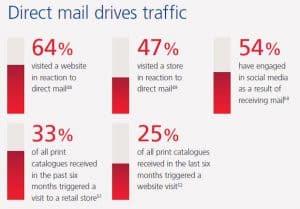01 Jan Why Direct Mail Works So Well

Measurability, effectiveness, quality experience, results. That’s why.
Why Direct Mail Works So Well
We have seen a renaissance of sorts in the use of direct mail by marketers who had either previously eschewed it in favour of digital media or who had never really tried it before. This latter group of marketers had been led to believe the often repeated (but incorrect) claims that direct mail was outmoded, only for older people, and required too much reading of people.
Those who had gravitated to digital media, but who are now rediscovering direct mail, cite such things as low engagement numbers for online media, poor response and conversion rates, and a lack of quality interaction with customers and prospects.
We love digital media, especially landing pages and email marketing. But the truth is that direct mail’s fall from grace after the advent of the digital age was more hype than fact. For those in the know, direct mail remained a vital part of the marketing mix because of its measurability, effectiveness, quality experience and because it gets results.
A study commissioned by Canada Post explored how direct mail plays into the lives of today’s consumers and how it influences purchase and other key marketing and sales objectives. The findings were summarized in a white paper titled “Breaking through the Noise,” available on the Canada Post website.
In a world flooded with stimuli competing for the typical consumer’s 8-second attention span, they found that:
• Direct mail inspires. It’s so ingrained in life that consumers ritualize it. In the process, they imbue it with emotionally charged meaning, making them more susceptible to inspiration from their brands.
• Direct mail gets noticed. Consumers are far more likely to notice, open, read, and enjoy mail than digital forms of advertising. They consider it less intrusive, more memorable, and the best way to make them feel valued.
• Direct mail persists. Consumers keep mail, display it in highly visible areas of their homes, and even share it with others. This creates multiple opportunities for a brand to be seen and engaged with.
• Direct mail persuades. Whether it’s to drive a store visit or purchase, mail delivers a call-to-action that resonates.
The study revealed direct mail’s effectiveness in a wide variety of metrics, just of few of which are seen here:
 So why does direct mail work so well for marketers? Here is our roundup of factors that makes direct mail uniquely successful.
So why does direct mail work so well for marketers? Here is our roundup of factors that makes direct mail uniquely successful.
It’s “direct” after all. Even most digital media are used in “non-direct” fashion, as a form of mass media. You will even hear the term “email blast” quite often. Here is the thing with direct mail: even when it is not personalized to an individual (and it should be whenever you can), it still is received in the home (carried from the mailbox) directly. It may be mass produced, but it inevitably feels like this package, post card, flyer or whatever is “for me”. This is a feeling, an engagement, that digital and other media simply cannot claim.
It is personal. Direct mail at its best is a personal medium. It can be addressed to an individual. It can be targeted to some, not to others. It can customize its message and even its graphics based on known information. It can be relevant and timely. Yes, email marketing at its best shares these attributes. But it lacks something direct mail will always have, which is…
It is physical and tactile. Ever picked up a tv commercial in your hand. Ever caressed an email message? Ever felt the quality touch of a radio spot? No other medium engages consumers’ sense of touch the way direct mail can. The paper, the shape, the folds, the weight and dimensionality, techniques such as embossing, varnish, die cuts. Done well, direct mail is an experience that one touches as much as one views.
Unparalleled creative versatility. While we are on the topic of direct mail’s physicality, let’s not forget that direct mail can be pretty much whatever you can dream up. You can make it 3D or flat, an intriguing shape, a fascinating fold, any size, any paper. Put whatever you want inside of an envelope. Or create a self-mailer that begs to be played with. Add tip-ons, scratch-offs or even scented material. No other medium gives marketers as much freedom to tell their story, engage their audience, and persuade potential buyers as direct mail.
It is targetable, customizable, segmentable. One campaign, multiple versions. Obviously personalized (addressed) direct mail lends itself best to trying different things to different people or groups. But even unaddressed mail can be customized and segmented. This of course brings up the idea of testing. You can test messages, offers, audiences,…pretty much any variable you can think of. And because you can track and measure response, conversion and purchase in a variety of ways, direct mail encourages continuous improvement. You don’t have to guess what works and doesn’t every time you mail, you have the ability to figure it out based on actual results.
It is cost effective. Yep, you read that right. While one of the most expensive media on a per thousand or per impression basis, the engagement, involvement, response, conversion and purchase that direct mail produces so much better than other media makes it highly cost-effective.
It plays well with others. Direct mail is very effective on its own. But it can be extremely powerful when combined with other media in a coordinated and integrated campaign. Especially digital media. Driving response online, especially to specially designed landing pages or microsites, is one of the smartest ways to maximize your market presence. Direct mail combined with email increases overall response rates. And direct mail has always played well with media such as television, radio and out-of-home.


